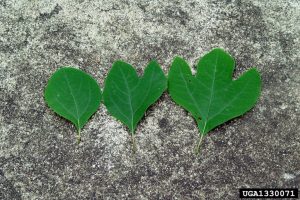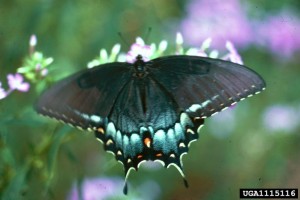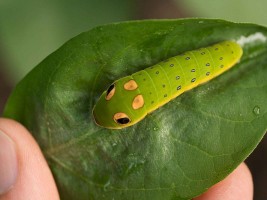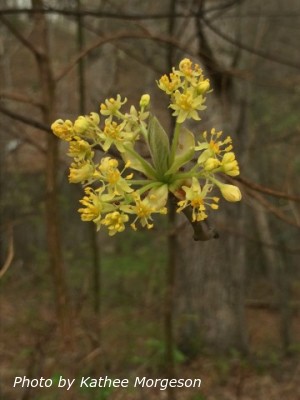By Kathee Morgeson
Time for sassafras trees to bloom, just after the serviceberry (Amelanchier spp.) start to fade. If you see one, you probably see many since they grow in wonderful thickets. Mine are being given the challenge of breezy days and threats of another night of frost. But, they have proven to stay closed just long enough to give that burst of sunshiny yellow to welcome spring in mid-April.
Sassafras (Sassafras albidum) can grow to 45-feet tall in dry, moist conditions. Squirrels and birds eat the fruit. The leaves are very interesting. They can be unlobed, mitten-shaped, or trilobed. Very cool!
Insects pollinate male and female flowers from separate trees. Sassafras is a host plant for the spicebush swallowtail butterfly and the promethea, IO, and imperial moths. I know I will be watching out for them this summer.

Sassafras leaves (Sassafras albidum), Photo courtesy of Chris Evans, University of Illinois, Bugwood.org
Males of the spicebush swallowtail are dark with distinctive greenish hindwings on upper surfaces.
In fall sassafras leaves turn red and yellow. Dave Tylka tells us that the leaves turning signal migrating cedar waxwings and thrushes that their energy-rich berries are ripe for picking proving once again that native flowers have evolved adaptations to convince animals to pollinate plants and disperse their seeds in his book, Native Landscaping for Wildlife and People.

Spicebush swallowtail, Photo courtesy of Charles T. Bryson, USDA Agricultural Research Service, Bugwood.org
Interesting notes taken from Wikipedia:
- All parts of the tree are fragrant.
- The largest known sassafras tree in the world is located in Owensboro, Kentucky, and measures over 100 feet high and 21 feet in circumference.
- Contains information on the historical cooking and medicinal uses of sassafras.
- Sassafras wood and oil were both used in dentistry.

Spicebush swallowtail butterfly larva on a spicebush leaf, Photo courtesy of Wikimedia
[Editor’s Note: Marcia and Dawn’s website references:
- Flora of North America
- Missouri Botanical Garden’s Plant Finder
- Lady Bird Johnson Wildflower Center Native Plant Database
- United States Department of Agriculture Plants Database
Also, Dawn recommends the book, Trees of Missouri, which also lists wildlife and medicinal uses.]



Thank you. So interesting.
Thank you. Love their amazing fall color but didn’t know about the spring blooms. Now how am I going to find a place for it in my yard?!
I had to find a place too and got them in 🙂
Does anyone know how old the trees need to be before they will start to bloom? Mine are probably only 3-4 years old and I don’t think I’ve seen any spring blooms yet.
Kathee,
Thanks for the article and photos of the sassafras tree, one of the prettiest, most under-appreciated native trees in America. I like the lyrical shape of the trunk and branches, the delicious scent and the great fall color, not to mention its ability to host one of the coolest caterpillars and loveliest butterflies to be found. I think a sassafras tree would make a great addition to any yard. Certainly they beat Bradford pears hands down for interest, beauty and wildlife support. And they aren’t invasive.